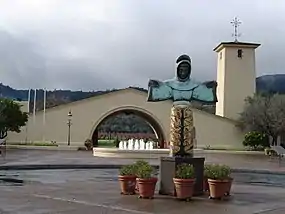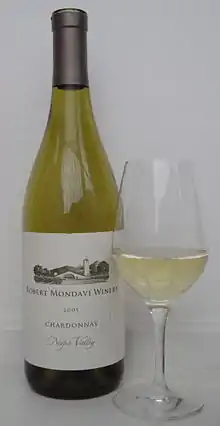Robert Mondavi
Robert Gerald Mondavi (June 18, 1913 – May 16, 2008) was an American winemaker. His technical and marketing strategies brought worldwide recognition for the wines of the Napa Valley in California. From an early period, Mondavi promoted labeling wines varietally rather than generically, which became the standard for New World wines. The Robert Mondavi Institute (RMI) for Wine and Food Science at the University of California, Davis opened in October 2008 in his honor.[1]
Robert Mondavi | |
|---|---|
 Robert Mondavi and his wife Margrit | |
| Born | June 18, 1913 |
| Died | May 16, 2008 (aged 94) |
| Occupations |
|
| Spouses | |
| Children | 3 |
| Awards | Order of Merit of the Italian Republic (2002), French Legion of Honour (2005) California Hall of Fame (2005) |
| Website | robertmondaviwinery |

Family history
Robert Mondavi's parents, Cesare Mondavi and Rosa Grassi, emigrated from Sassoferrato[2] in the Marche region of Italy and settled in Hibbing, Minnesota. Robert Gerald Mondavi was born in Virginia, Minnesota. From Minnesota the Mondavi family moved to Lodi, California, where he attended Lodi High School. In Lodi, his father, Cesare, established a fruit packing business under the name C. Mondavi and Sons, packing and shipping grapes to the east coast primarily for home winemaking. Mondavi graduated from Stanford University in 1937 with a degree in economics and business administration. While at Stanford he was a member of the Phi Sigma Kappa fraternity.
In 1943, Mondavi joined his father and brother Peter after the family acquired the Charles Krug Winery located in St. Helena, California, from James Moffitt. In 1965, Robert Mondavi left the family winery after a feud with his younger brother Peter over the business direction of the Krug Winery. Subsequently, Mondavi started his own winery in Oakville, California.[3] The Robert Mondavi Winery is located on Highway 29 between Oakville and Rutherford (though its corporate headquarters are in nearby St. Helena.)
In 1966, he founded the Robert Mondavi Winery, the first major winery built in Napa Valley in the post-Prohibition era. Part of Mondavi's original vineyard land included the To Kalon (a Greek term meaning "the beautiful") vineyard originally established by Napa Valley pioneer H.W. Crabb in 1868. The winery produced wine in the California mission style. Mondavi selected Cliff May to design the winery building, which opened in 1966 and is now considered an architectural icon in the Napa Valley,[4] with an expansive entryway arch and bell tower.
Family
In 1937, Mondavi married his high school sweetheart, Marjorie Ellen (Declusin) Mondavi. Together, the couple had three children: Michael, Marcia, and Tim. In the late 1970s, their marriage ended in a divorce. In 1980, at the age of 67, he married Margrit (Kellenberger) Biever Mondavi, a Swiss-born, and multilingual woman who worked at the Robert Mondavi winery.[5]
Wine history

In 1968, Mondavi made a dry oak–aged Sauvignon blanc, an unpopular variety in California at the time, and labeled it "Fumé Blanc". The name Fumé Blanc, derived from combining parts of the terms "Pouilly ‘Fumé" and ‘Sauvignon Blanc", became accepted as a synonym for Sauvignon Blanc.
Mondavi entered into a joint venture with Baron Philippe de Rothschild of Château Mouton Rothschild to create Opus One Winery, and since the 1990s has set up joint ventures with local partners in Europe, South America and Australia.[6]
In the Grand European Jury Wine Tasting of 1997, the Robert Mondavi Chardonnay Reserve was ranked number one.
In 2005, Robert Mondavi and his younger brother Peter made wine together for the first time after their feud. Using grapes from both family vineyards, they produced one barrel of cabernet blend, which was sold for $400,000 under the name "Ancora Una Volta" ("Once Again") at the 2005 Napa Valley Auction.[7] All the money earned from the barrel of wine went to charity.
Legacy
In 2003, Mondavi expressed regret and criticized his sons for the business strategy that emphasized the inexpensive Mondavi lines, Coastal and Woodbridge, over the premium wines, allowing the company name to lose its association with fine wine it held in the past. He said, "We've got to get our image back, and that's going to take time."[8]
In the 2004 documentary film Mondovino, the Mondavi family featured prominently, in close application to its theme of globalization. At the time, the Mondavis had recently acquired the Italian "cult wine" Ornellaia winery, Tenuta Dell'Ornellaia.

On December 22, 2004, Constellation Brands acquired the Mondavi winery in a controversial takeover for nearly US$1.36 billion in cash and assumption of debt.[9] Following the sale of the company, Mondavi partnered with his younger son Tim Mondavi and daughter Marcia Mondavi to make a single wine from a single estate at the highest level. The family partnership Continuum Estate is still run by the family.
In 2001, Robert Mondavi donated $10 million to help with the building cost of the Robert and Margrit Mondavi Center for the Performing Arts building at UC Davis. The Mondavi Center was opened on October 3, 2002. Robert also donated $25 million to establish the Robert Mondavi Institute for Wine and Food Science and this opened a new era for UC Davis’s wine and food programs. It was the largest private contribution to UC Davis.
The two were founders and major benefactors behind the museum Copia, which opened November 2001 in the city of Napa, California.
Robert and Margrit were also founding supporters of the restoration of the 19th-century Napa Valley Opera House and the Oxbow School, a new art school in Napa that provides grants and instruction to art students in their junior year of high school. They have contributed to the restoration of the Lincoln Theatre in Yountville, California, and have supported the Cantor Arts Center at Stanford University in Palo Alto, California.
Published works
- Modavi, Robert (1998). Harvests of Joy: How the Good Life Became Great Business. Mariner Books.
Awards and honors
In 1985, Mondavi received the Golden Plate Award of the American Academy of Achievement.[14]
Robert Mondavi was selected as the Decanter "Man of the Year" in 1989.[11] He was inducted into the Junior Achievement U.S. Business Hall of Fame in 1991.
In 2000 he was awarded Doctor of Oenology, Honoris Causa, by the Board of Trustees of Johnson & Wales University.
In 2002, he received the Order of Merit of the Italian Republic.[15] In 2005, he received the Legion of Honour from the French government.
On December 5, 2007, California Governor Arnold Schwarzenegger and First Lady Maria Shriver inducted Mondavi into the California Hall of Fame, located at The California Museum for History, Women and the Arts.[16]
He was inducted into the Culinary Institute of America Vintner's Hall of Fame in 2007.[17] The election was based upon ballots from seventy wine journalists. The decision for their election of Mondavi is for contributions to the wine industry of California during his lifetime.
Robert Mondavi was awarded the Presidential Gold Medal of the Confrerie de la Chaine des Rotisseurs in December 2006 for his many contributions to the Society.
See also
Further reading
- Siler, Julia Flynn (2008). The House of Mondavi: The Rise and Fall of an American Wine Dynasty. Gotham. ISBN 978-1-59240-259-5.
References
- "Robert Mondavi Institute for Wine and Food Science Opens". University of California, Davis. October 10, 2008.
- Prial, Frank J. (May 16, 2008). "Robert Mondavi, Napa Wine Champion, Dies at 94". The New York Times.
- Davis, Kip (September 15, 2011). "Peter Mondavi leads Krug's 150th anniversary celebration". Napa Valley Register. Lee Enterprises, Inc. Retrieved September 15, 2011.
- "Architectural Wine-World Wonders". Wine Enthusiast Magazine. March 27, 2013. Retrieved September 3, 2019.
- Prial, Frank (May 17, 2008). "Robert Mondavi, Napa Wine Champion, Dies at 94". New York Times. Retrieved May 20, 2014.
- Julien Lefour, Comment les cépages de tradition française deviennent des vins californiens ?, Communications, n°77, 2005, 16 p. (Edgar Morin Center – EHESS/CNRS). Free downloading sur http://www.persee.fr
- Patricia Sullivan, "Robert Mondavi 94; Noted Vintner Who Raised Qualities of American Wine", Washington Post, May 17, 2008, p. B5. Accessed 24 May 2008.
- Frank J. Prial (July 2, 2003). "With Head Held High, Mondavi, at 90, Faces a Storm". The New York Times.
- Carol Emert (November 4, 2004). "Legendary California wine company is sold". San Francisco Chronicle. Retrieved November 13, 2007.
- Laube, James, Wine Spectator (May 17, 2008). "Robert Mondavi Dies at Age of 94". Archived from the original on July 19, 2008. Retrieved May 16, 2008.
{{cite web}}: CS1 maint: multiple names: authors list (link) - Lechmere, Adam, Decanter.com (May 16, 2008). "'Colossus' Robert Mondavi dies".
{{cite web}}: CS1 maint: multiple names: authors list (link) - Hubler, Shawn (May 17, 2008). "California wine came of age under him Vintner elevated state's wines". Los Angeles Times. Retrieved October 9, 2010.
- Carson, l. Pierce (May 16, 2008). "Winery patriarch dead at 94 Mondavi passes: 'We've lost our leader'". Napa Valley Register. Napa, CA: Lee Enterprises, Inc. Retrieved September 18, 2011.
- "Golden Plate Awardees of the American Academy of Achievement". www.achievement.org. American Academy of Achievement.
- Intardonato, John (June 19, 2013). "Just remembering Robert Mondavi". Napa Valley Register.
- Mondavi inducted into California Hall of Fame Archived January 10, 2008, at the Wayback Machine, California Museum. Accessed 2007.
- "Vintners Hall of Fame Inductees - Robert Mondavi 1913–2008 Inducted 2007". The Culinary Institute of America. 2014. Archived from the original on October 6, 2014. Retrieved July 21, 2020.
External links
- Robert Mondavi official site
- Napa Valley Wine Co. the story and historical documents re. Charles Krug, Jacob Beringer/Beringer Bros., and Cesare/Robert Mondavi (in German)
- Robert G. Mondavi Papers at Special Collections Dept., University Library, University of California, Davis
- Robert Gerald Mondavi at Find a Grave